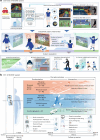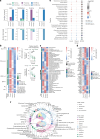An adaptive AI-based virtual reality sports system for adolescents with excess body weight: a randomized controlled trial
- PMID: 40551019
- PMCID: PMC12283417
- DOI: 10.1038/s41591-025-03724-5
An adaptive AI-based virtual reality sports system for adolescents with excess body weight: a randomized controlled trial
Abstract
Adolescents with obesity face numerous health risks and encounter barriers that lead to physical inactivity. We developed a virtual reality sports system, named REVERIE (Real-World Exercise and VR-Based Exercise Research in Education), which used deep reinforcement learning to train transformer-based virtual coaching agents, offering immersive and effective sports guidance, with biomechanical performance comparable to real-world physical sports. We integrated REVERIE into a randomized controlled trial involving an 8-week intervention in adolescents with excess body weight (n = 227). Participants were randomized (1:1:1:1:1) to physical table tennis, physical soccer, REVERIE table tennis, REVERIE soccer or control. REVERIE sports intervention was effective in reducing primary outcome fat mass (mean -4.28 kg (95% confidence interval (CI) -6.35 to -2.22), relative to control), with no significant difference compared with physical sports (mean -5.06 kg (95% CI -7.13 to -2.98), relative to control). For secondary outcomes, decreases in liver enzymes and low-density lipoprotein cholesterol levels were found in physical and REVERIE sports groups compared to control. Physical and REVERIE sports showed improvements in physical fitness, psychological well-being and sports willingness after an 8-week intervention, which remained at the 6-month follow-up in the REVERIE sports group. REVERIE sports demonstrated superior cognitive enhancements compared to physical sports in exploratory analyses, as evidenced by olfactory tests (total score: mean 2.84 (95% CI 1.15 to 4.53)) and working memory paradigm (2-back accuracy: mean 10.88% (95% CI 1.19% to 20.56%)). Functional magnetic resonance imaging exhibited that REVERIE sports enhanced neural efficiency and neuroplasticity. Multi-omics analyses revealed distinct changes induced by REVERIE sports that were closely associated with cognitive improvement. Minimal injury rates were 7.69% for REVERIE and 13.48% for physical sports, with no serious adverse events. Collectively, this study demonstrates that the virtual reality sports therapy could provide an empathetic approach to addressing adolescent obesity, offering comprehensive improvements in physical, psychological and cognitive health beyond mere weight loss. Clinical Trial registration: ChiCTR2300068786 .
© 2025. The Author(s).
Conflict of interest statement
Competing interests: B.S., Huating Li, Y.Q., Q. Wu, Q. Wang and Haoxuan Li are inventors on a pending invention disclosure related to this work filed by Shanghai Sixth People’s Hospital and Shanghai Jiao Tong University (no. PCT/CN2025/071039, filed in January 2025). The other authors declare no competing interests.
Figures














References
Publication types
MeSH terms
LinkOut - more resources
Full Text Sources

